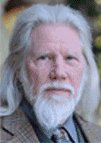Whitfield Diffie
- Birthdate
- 1944/06/05
- Birthplace
- Washington, DC, USA
- Associated organizations
- MIT
- Fields of study
- Cryptography, Computing
- Awards
- IEEE Donald G. Fink Prize Paper Award, IEEE Information Theory Society, IEEE Richard W. Hamming Medal
Biography
Whitfield Diffie was born on 5 June 1944 in Washington, D.C. to Bailey Wallys Diffie, a professor of history at the City College of New York, and Justine Louise Whitfield, a writer and expert on Madame de Sévigné. Diffie was raised in an upper middle class, Jewish immigrant neighborhood of Queens, a community which was particularly leftist and progressive. This was a culture Diffie chased all his life, and was largely responsible for his future move to California. Diffie believed his mother to be rather liberal, while he has described his father as "an extremely conservative person."
It was not until the age of ten (fifth grade) that Diffie learned to read. The same year, his father brought home several books on cryptography from the City College library, thus sparking an interest in computers which Diffie would eventually rekindle at MIT.
Throughout high school, Diffie was interested in pure mathematics. Despite being a self-proclaimed "mediocre student," he was admitted to MIT and graduated with a B.S. in Mathematics in 1965. During his first two summers in college, Diffie visited the University of California, Berkeley. He preferred the social atmosphere of Berkeley to MIT and seriously considered transferring, although his father convinced him otherwise. Diffie claims that he was unhappy at MIT and "barely graduated."
After graduating from MIT, Diffie's grades were too low to continue onto graduate school, but he wanted to avoid the Vietnam draft. His solution was a job at the federally funded MITRE Corporation, then located on the MIT campus. It was while working for MITRE that Diffie became a residence guest of Marvin Minsky at the MIT artificial intelligence lab and regained interest in computers. Diffie also worked on MATHLAB—a computer algebra program now known as Macsyma—under the guidance of Roland Silver. In 1969, with funding running low and Diffie reaching the draft cut-off age, he left MITRE and moved to Stanford to work under John McCarthy at the Stanford artificial intelligence lab.
Diffie's experiences at Stanford were instrumental to his future developments in cryptography. He worked on his first security problem for the ARPAnet and read the entirety of The Codebreakers by David Kahn. The combination of Diffie's interest in applied mathematics and concerns for individual privacy made him the perfect cryptography student.
In 1973, Diffie took a leave of absence from Stanford to travel across the US and learn as much about cryptography as possible. There were two problems that Diffie wanted to solve: first, all cryptosystems were dependent on a third party which inherently limited their security, and second, there was a need for some method of "digital signature" which would allow the authentication of online communications. At the time, almost all information on cryptography was kept secret by the National Security Agency (NSA), and what information was available was scattered across the US.
Upon returning to Stanford, Diffie joined Dr. Martin E. Hellman to work on developments in cryptography. After four to six months, the research team was also joined by graduate student Ralph C. Merkle, and in November of 1976 they published "New Directions in Cryptography" which introduced the idea of the Diffie-Hellman key exchange (publicly shared key). This single paper solved the problem of third parties and digital signatures through the use of two keys, one public and one private. The Diffie-Hellman key exchange was then developed into the RSA public cryptosystem by MIT mathematicians Ronald L. Rivest, Adi Shamir, and Leonard M. Adleman.
Diffie became manager of secure systems research at Northern Telecom, a position which he held through the 1980s. In 1992, Diffie received an honorary doctorate from Swiss Federal Institute of Technology, and in 1998 he co-published Privacy on the Line with Susan Landau.
Diffie received the IEEE Donald G. Fink Prize Paper Award, 1981; the NIST/NSA National Computer Systems Security Award, with Martin Hellman, 1996; the Franklin Institute’s Levy Medal, with Martin Hellman, 1997; the ACM Kannellakis Award, with Martin Hellman, 1997; the IEEE Information Theory Society Golden Jubilee Award, with Martin Hellman, 1998; the IEEE Kobayashi Award, with Martin Hellman and Ralph Merkle, 1999; Fellow, International Association for Cryptographic Research, 2004; the IEEE Richard W. Hamming Medal, with Martin Hellman and Ralph Merkle, 2010; and the ACM Turing Award, with Martin Hellman, 2015. In 2011, he was inducted into the National Inventors Hall of Fame, and in 2017, he was elected a Fellow of the Royal Society.
He is currently a consulting professor at CISAC (The Center for International Security and Cooperation at Stanford University) where he was previously a Visiting Scholar (2009) and Affiliate (2010-2012).
Further Reading
Diffie, W., and M. E. Hellman. "New Directions in Cryptography." IEEE Trans. Inf. Theory IT-22 (1976): 644-654.
Kahn, David. The Codebreakers, rev. ed. New York: Scribner, 1996.
Levy, Steven. "Battle of the Clipper Chip." New York Times Magazine, July 12, 1994.
Levy, Steven. Crypto: How the Code Rebels Beat the Government Saving Privacy in the Digital Age. New York: Penguin, 2001.
Levy, Steven. "Prophet of Privacy." Wired Magazine, November 1994.
